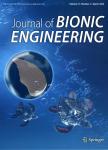Morphological, Physical, Mechanical, Chemical and Thermal Characterization of Sustainable Indian Areca Fruit Husk Fibers (Areca Catechu L.) as Potential Alternate for Hazardous Synthetic Fibers
Morphological, Physical, Mechanical, Chemical and Thermal Characterization of Sustainable Indian Areca Fruit Husk Fibers (Areca Catechu L.) as Potential Alternate for Hazardous Synthetic Fibers作者机构:Department of Mechanical Engineering St. Xavier' s Catholic College of Engineering Nagercoil - 629003 India Department of Mechanical Engineering VV College of Engineering Tisaiyanvilai - 627657 India Department of Chemistry St. Xavier' s Catholic College of Engineering Nagercoil - 629003 lndia
出 版 物:《Journal of Bionic Engineering》 (仿生工程学报(英文版))
年 卷 期:2016年第13卷第1期
页 面:156-165页
核心收录:
学科分类:082902[工学-木材科学与技术] 08[工学] 0829[工学-林业工程] 0805[工学-材料科学与工程(可授工学、理学学位)] 080502[工学-材料学]
基 金:Department of Science and Technology Ministry of Science and Technology India डीएसटी
主 题:bio-reinforced polymer composites Areca husk fibers physical properties chemical properties
摘 要:Natural fibers can play a major role in composite industry due to its renewable, biodegradable, and eco-friendly properties. Areca Fruit Husk (AFH) is rich in fiber, but is wasted in large quantity from tobacco industries. Comprehensive characterization of AFH fiber is done to examine its morphological, physical, mechanical, chemical and thermal properties. High cellulose content of the fiber (57.35 wt%) provides better tensile strength (231.66 MPa) whereas the porous surface morphology (40.8 %) ensures better bonding with the matrix. Moreover, the low density of the fiber (0.78 ***^-3) makes it an attractive alternative for hazardous synthetic fibers. The semi-crystalline nature and large crystalline size of the fiber reduce the water absorption char- acteristics. The thermo gravimetric analysis confirms its stability up to 240℃, which is higher than the polymerization tem- perature. The results confirm the potential of AFH fibers as a reinforcement in bio-reinforced polymer composites for automo- tive and structural applications.



